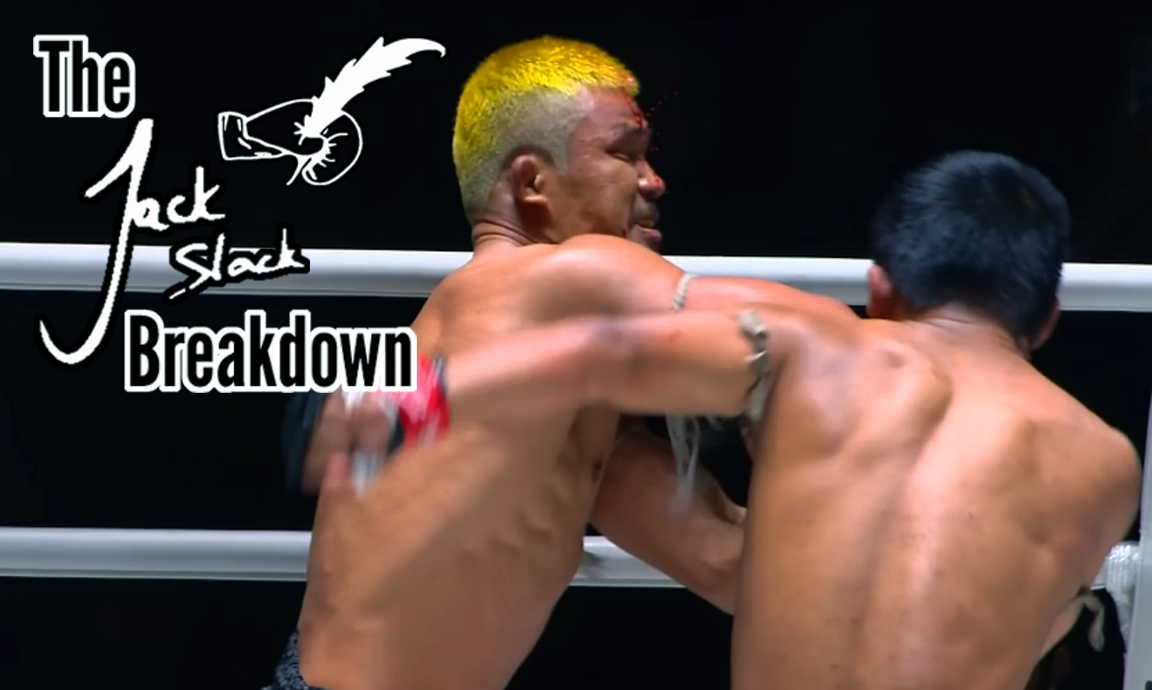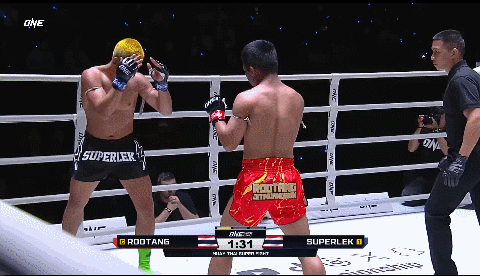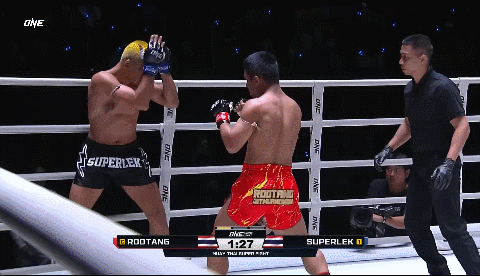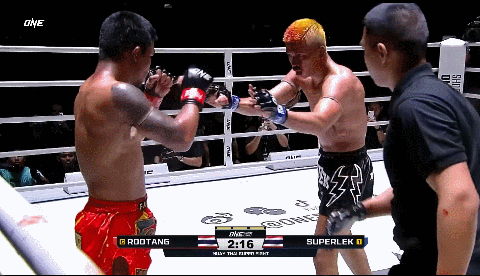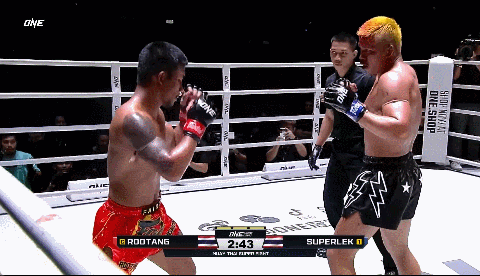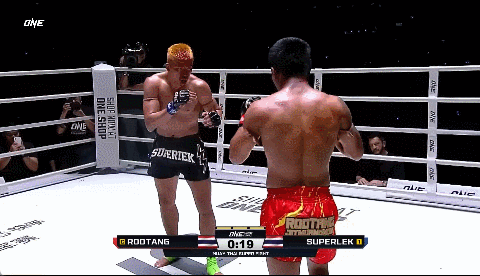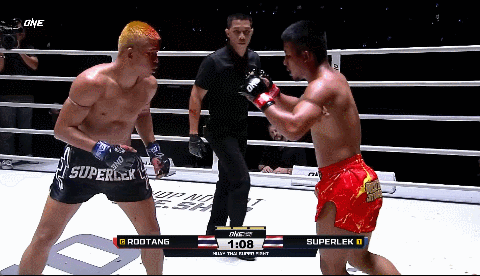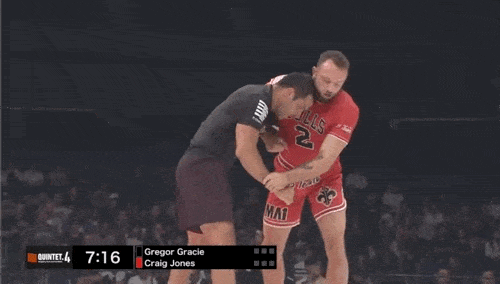Superlek vs Rodtang
~ Fiziev vs Gamrot ~
The Jack Slack Breakdown
Superlek is a darling of Muay Thai purists. He has two Lumpinee championships to his name, and his skills have held up just as well under ONE Championship’s more action oriented, four ounce rules. Rodtangs major stadium achievement is having two “Fight of the Year” awards from Rajadamnern. Going into this fight, Rodtang was considered an action fighter who found his calling in ONE Championship, while Superlek was seen as someone who had reached the pinnacle of Muay Thai before finding ONE Championship as a new way to make some cash off his skills. For many it seemed they were obviously a class apart, but as is so often the case in the sport of professional fist fighting: the contest between Rodtang and Superlek did something to shift those perceptions.
Slacky’s note: Superlek versus Rodtang is freely available on ONE Championship’s Youtube channel and has two million views at the time of writing. This allows me to feel justified in using gifs to illustrate my points, but the whole fight deserves watching at least once.
Rodtang opened the fight by trying to walk Superlek down, and Superlek attempted to score immediately with his powerful right round kick. Rodtang got to the check on a couple, ate a couple, and continued the push towards the ropes. Rodtang’s entries have often been pretty simplistic: he most commonly initiates with a left hook to the body, or a right overhand into stepping left knee. The latter combination worked nicely along the ropes early this fight because the right knee served as a stuff or check when Superlek attempted to return with his favourite right kick.
Fig. 1
The bout was thrown into chaos within the first two minutes as Rodtang lunged for a left hook to the body while Superlek gave ground towards the ropes. The left hook fell short and as Rodtang ploughed in behind it, Superlek’s elbow and forearm clattered off Rodtang’s chin. It was an excellent counter but the reason that Rodtang can lead with the left hook to the body constantly is that he wants trades. Those are the kind of trades he thrives off. As Superlek was trying to push his advantage from what should have been a fight changing connection, Rodtang framed off him and threw a right elbow back that shredded the skin of Superlek’s forehead.
Fig. 2
Superlek is no slouch with the elbows. In his last fight he took a break from kicking to show off some of his more aesthetic elbow strikes against Tagir Khalilov. The issue of elbowing with Rodtang was that he would take it and elbow back. There wasn’t a whole lot more to it: Rodtang is one of those special individuals like Rocky Marciano. He can take far more damage than he should be able to, and he will always throw back with the meanest of intentions, with little regard for his own safety. Every time the two men came together, Rodtang would commit his weight so fully to each elbow strike that his chin would whip up in the air, but he never seemed in danger of being made to pay for it simply because he is Rodtang.
Fig. 3
Before the major cut was scored off a counter elbow, Rodtang had already opened Superlek with an up-elbow. This pairs well with his left hook to the body and left hook to the head as a lead. Whenever Superlek stood still with his guard up, or closed for another crack at Rodtang off an exchange, he was in danger of eating the up elbow which thwacked in at least a half dozen times through the three rounds.
Fig. 4
Superlek’s adjustment was marvellous. Rather than trying to circle and kick, he found a way to impose his physicality on Rodtang. From the midpoint of the second round, Superlek’s use of the double hand check was constant. If Rodtang opened up to swing the left hook to the body, Superlek would feel it and either pop Rodtang on the counter as he came forward, or give ground and pop him on the way back.
Fig. 5
He also snuck in the odd backhanded jab when he felt Rodtang holding firm. A technique I am sure he learned from heavyweight MMA great, Daniel Cormier.
Fig. 6
From the double hand check, Superlek could not only read Rodtang better and eliminate the risk of the up-elbow, he could physically move Rodtang. In the third round, Superlek almost pushed Rodtang through the ropes just by placing hands-on-hands.
Fig. 7
While Superlek was able to drop Rodtang early in the second round in an elbowing exchange, it was within these exchanges that he was getting roughed up. Even when Superlek had biceps ties, Rodtang would smack him with a couple of partial elbows until the referee broke them.
Fig. 8
So the latter part of the fight was dominated by a strategy of punch-and-clutch from Superlek. Or more accurately, “knee-and-clutch.” Using his double hand check to eliminate the boxing portion of the fight altogether, Superlek would pitch a right knee to the midsection and then fall into a clinch with an emphasis on achieving a true tie up. Through the third round he stopped allowing the exchanges where Rodtang’s ridiculous physical gifts could allow him into the fight, and instead buried his head in Rodtang’s chest—well out of the way of elbows.
Fig. 9
I have not checked in with the Muay Thai online community but I can imagine the referee breaks off these double underhooks positions were not received well. In a traditional Muay Thai fight, Superlek would be allowed to work from here and he was active with his knees even with the referee breaking the clinch moments after locked his hands.
Overall the fight was a joy to watch. To return to the Rocky Marciano reference earlier: some people are just built differently. This fight took on one of the rarest dynamics you will see in combat sports. Once he made his adjustments, Superlek had the read on Rodtang and did pretty much everything right to land his own strikes and limit Rodtang’s. And yet in spite of commanding the action and making the correct reads, there was never a moment in this fight that Superlek didn’t look as if he was fighting for his life. From the outside, it seems like fighting Rodtang is an absolutely miserable experience, even for the most experienced ring generals in the game.
Fiziev vs Gamrot
The highlight of the weekend in the MMA sphere was supposed to be Mateusz Gamrot versus Rafael Fiziev. It was another fire-and-ice style clash in the cutthroat lightweight division, until it wasn’t. Rafael Fiziev threw a right round kick that slapped against Gamrot and injured Fiziev in the process. While that is another highly anticipated fight ruined early by spontaneous knee explosion, the fight had a couple of interesting moments worth remarking on.
For a while we have been discussing the striking game with a focus on the principles of “open stance” and “closed stance” rather than “southpaw” and “orthodox.” This is because in mixed martial arts, more than half of fighters now engage in at least a little switch hitting. When one man is switching stances, he controls the open stance – closed stance dynamic and decides which techniques are appropriate and when. When both men are switching this becomes more complicated, as I yammer on about on the podcast when it is Sean O’Malley fight week.
But in the modern era of MMA striking, a fighter might be best served to focus on having a couple of good, stance match-up appropriate leads, and making sure to be able to use them off both stances. Then it is a case of identifying the stance dynamic and slotting the correct technique in. In this fight, both men showed great awareness of the opponent’s propensity to switch stances and attacked the opponent on the switch, with the appropriate weapon for the stance they were moving into.
In Figure 10 Gamrot lands a good right straight as Fiziev changes to southpaw. This is a simple tactic but it comes down to confidently shooting the rear straight as the opponent’s brain is making the switch from one stance to the other. A great example of this principle in boxing is Gennady Golovkin’s knockdown of Danny Jacobs. After having trouble with Jacobs’ switch hitting, Golovkin waited on the switch and hit Jacobs’ while he was still in the process of changing leads.
Fig. 10
In good hitting the switch is done in motion, to hide what you’re doing and to avoid the instant counter. Fiziev repeatedly levels out his stance and circles off to his left—sometimes going southpaw in the process and sometimes returning to orthodox. Gamrot was able to read this and land a good right straight during the circle out.
When Gamrot switched stances on the retreat and wound up in a closed stance, Fiziev immediately hammered in the rear leg calf kick: an exclusively closed stance weapon.
Fig. 11
The wrestling portions of the fight played out as expected: with Fiziev defending and scrambling well, and Gamrot chaining takedowns in the way that only he can. The issue with Gamrot’s style seems to be that he exerts an enormous amount of effort chaining techniques to get the fight to the mat, but utterly fails to control his opponent in the moments after their rump hits the canvas.
A large part of Gamrot’s trouble seems to stem from the fact that his takedowns often involve getting to the single leg and then attempting to finish by raising the trapped leg as high as possible (the “tree topper”) and kicking out the standing leg. Rather than trying to graduate from a single leg to a body lock, or gain control of both his opponent’s feet, all of Gamrot’s finishes leave his opponent’s other leg free to begin scrambling.
Fig. 12
Furthermore, the tree topper just doesn’t seem to work as well in the lighter weightclasses. Glover Texeira could send Jiri Prochazka clattering into a heap on the floor by getting his foot above shoulder height, but against Gamrot, Arman Tsarukyan and Rafael Fiziev both comfortably hopped about on one foot until they could slip their elevated leg free.
A final noteworthy fight from the weekend was Charles Jourdain versus Ricardo Ramos. The fight demonstrated the play-off between the guillotine and the Von Flue choke. As Jourdain wrapped the head off a Ramos takedown, Ramos hopped past the guard and into side control. While the commentators pointed out that the Von Flue choke was a danger, Jourdain held the head and continued trying to work his way back to guard with the head still wrapped. Ramos kept driving his feet into the mat and taking his knees off the floor to try and put pressure on the Von Flue (b), and Jourdain kept using this to sneak his knee back in and threaten to replace guard (c). Notice that Jourdain immediately gets up to his hand once the guard is replaced, threatening the stand up and encouraging Ramos to push into him (d).
Fig. 13
The big moment of this fight came off an octopus underhook from the bottom. The octopus underhook has always been a bad guard move, but a great scrambling move. If you want to hold someone in guard, it’s only going to make your life harder, but if you want to get up or make something happen the octopus underhook is invaluable. Khabib Nurmagomedov spent less than a minute on the bottom in his UFC career and immediately used the octopus underhook to get up.
Craig Jones was taken down by Gregor Gracie a couple of weeks ago and used the octopus underhook to scramble up. Gracie was so upset by this refusal to stay down that he sat down and let Jones mount him.
Fig. 14
Figure 15 shows how Jourdain used the octopus underhook against Ramos. Ramos passes to side control and Jourdain punches through the octopus underhook (b). Jourdain raises his hips to come up to the turtle (c), and as Ramos tries to run around him, Jourdain sits back, threatening to take Ramos’ back (d). Ramos rolls to evade this but loses top position (e).
Fig. 15
As Ramos hurried to get back on top, he tried to bundle Jourdain over from the knees and left his neck out for the guillotine. It was almost identical to Charles Oliveira’s loss to Ricardo Lamas. Lamas repeatedly threatened to stand up and Oliveira dived recklessly into the guillotine in the course of trying to stay on top.

